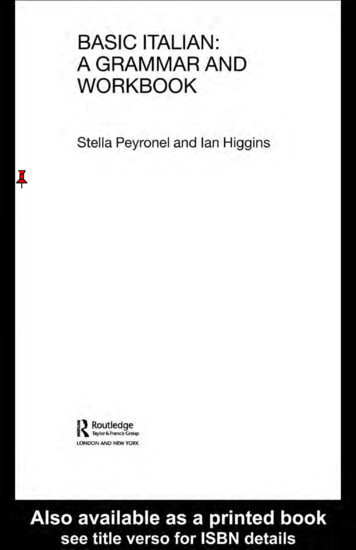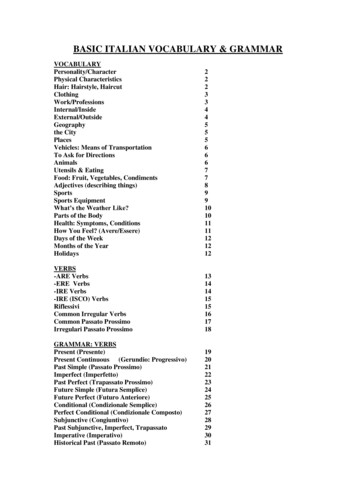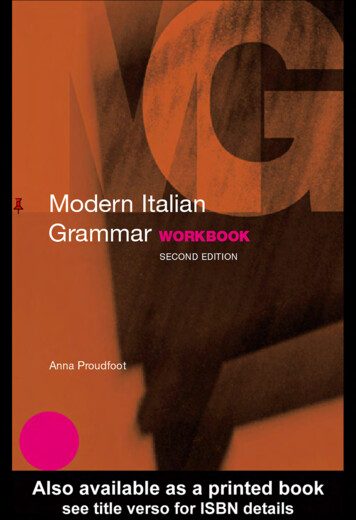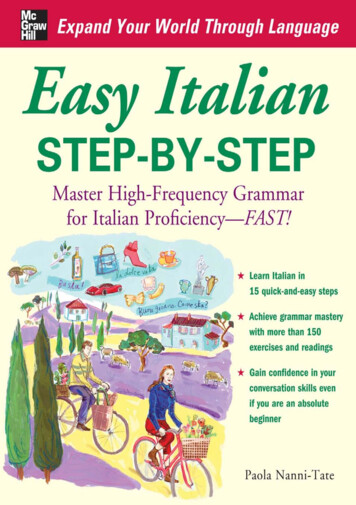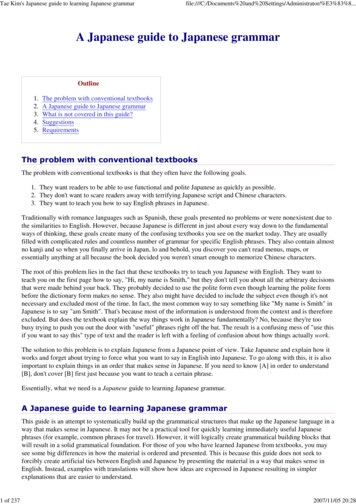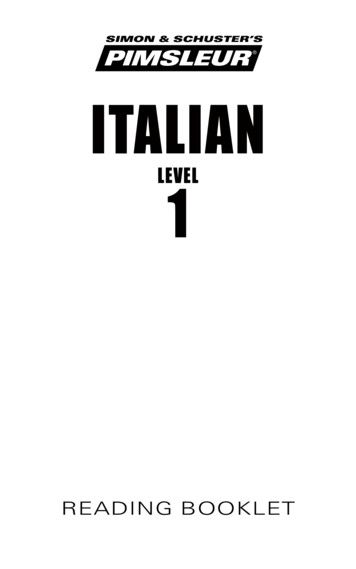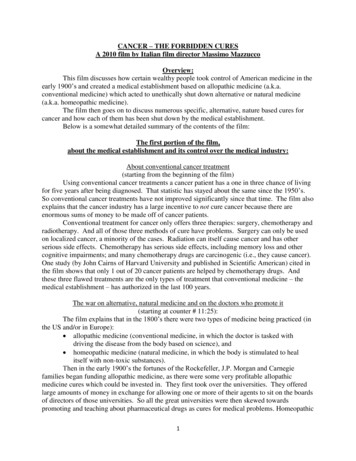
Transcription
Chapter 10Learning an Italian Categorial GrammarR. Bernardi, A. Bolognesi, C. Seidenari, F. Tamburini1. Grammar LearningCategorial Grammar (CG) is a lexicalized formal grammar well known for itstied connection between syntax and semantics. Variants of it (CombinatoryCategorial Grammar, CCG, and Categorial Type Logic, CTL) have been usedto reach wide coverage grammars for English (Hockenmaier 2003) and Dutch(Moortgat and Moot 2002). The former has resulted into a large CCG Bankthat has been enriched with semantic information (Bos 2005; Clark and Curran2007; Curran, Clark and Bos 2007). Therefore, CG elegant syntax-semanticsinterface has already provided promising preliminary results. This connectionis even more tied in the CTL framework where it is represented by a formalcorrespondence between derivations and lambda-calculus rules (viz. CurryHoward Correspondence (Van Benthem 1986)). In this work we adopted theCTL version of CG. Differently from CCG, composed only by logical rules,CTL is based on logical rules, that create linguistic structures, and structuralrules, that take care of cross-linguistic word-order variations.Following Hockenmaier 2003, the task of learning CTL can be divided intoseveral sub-tasks: (i) learning the types from existing treebanks; (ii) parsingraw corpora to build a CGBank, a bank of derivations; (iii) learning semanticlabeling of the derivations. Furthermore, the type learning could be further
186 R. Bernardi, A. Bolognesi, C. Seidenari, F. Tamburinienhanced by inducing structural rules that will help ltering out the sets oftypes without loss of information. In Bernardi and Bolognesi 2006 we havepresented a statistical parser to help building a bank of Italian CG derivations.In this paper, we focus on discussing the treebank we start from, the preprocessing work we had to carry out, and presenting our preliminary results.Our ultimate goal will be the annotation of CORIS/CODIS, a 100-millionword synchronic corpus of contemporary written Italian. Our starting point,instead, is TUT (Turin University Treebank), a collection of syntactically annotated Italian sentences (1,800 sentences) with dependency relations.This paper has the following structure. In Section 2 we recall grammarformalisms we dealt with in order to obtain a CG treebank. In Section 3we discuss the preprocessing needed for translating TUT structures into CGbinary trees. In Section 4 we study the translation from TUT to CG trees. InSection 4.3 and 5 we brie y discuss future steps we are planning in order toimprove our CG treebank. In Section 6 we draw some conclusions.2. Formal GrammarsSince our starting point is TUT, a dependency treebank, and our goal is tobuild CG derivations, a rst important step is to translate the TUT dependencytree into the latter. Before going into the details of the pre-processing phase,we brie y introduce the two formalisms and highlight their similarity anddifferences.2.1. Dependency Grammar and TUT formatThe Turin University Treebank (TUT) is a corpus of Italian sentences annotatedby specifying relational structures augmented with morpho-syntactic information and semantic role (henceforth ARS) in a monostratal dependency-basedrepresentation. The treebank includes 38,653 words and 1,800 sentences fromthe Italian civil law code, the national newspapers La Stampa and La Repubblica,and from various reviews, newspapers, novels, and academic papers.The ARS schema consists of i) morpho-syntactic, ii) functional-syntacticand iii) semantic components, specifying part-of-speech, grammatical relations,
Leaning an Italian Categorial Grammar187and thematic role information, respectively. The reader is referred to Bosco2003 for a detailed description of the TUT annotation schema.Because we are interested in extracting dependency relations, we can focuson the functional-syntactic component of the TUT annotation, where information relating to grammatical relations (heads and dependents) is encoded.In TUT structures, each node is labelled by a word; each edge is labelled bya grammatical relation. The information concerning a single node word is asfollowsn word ( f1 f2 . fn ) [H ; MORPH S Y NT S EM ]where, n is the number of the linear order of the word occurrence; fi aremorphological features associated with the word itself; MORPH S Y NT S EM are the grammatical relation concerning the dependency edge linkingthe word with its syntactic head (H ).An example is given below (tr. Berisha is the candidate of a party ): thenode TOP-VERB is the root of the whole structure1 .12345678Berishaèilcandidatodiunpartito.(Berisha NOUN PROPER)(ESSERE VERB MAIN IND PRES INTRANS 3 SING)(IL ART DEF M SING)(CANDIDATO NOUN COMMON M SING)(DI PREP MONO)(UN ART INDEF M SING)(PARTITO NOUN COMMON M SING)(#. PUNCT)[2;VERB-SUBJ][0;TOP-VERB][2;VERB-PREDCOMPL SUBJ][3;DET DEF-ARG][4;PREP-RMOD][5;PREP-ARG][6;DET INDEF-ARG][2;END]In the following we will use dependency structure format that are easierto read and compare with the CG binary trees: arrows link a dependent withits head by pointing to it and carrying the grammatical relation as illustratedby our running example:VERB-SUBJBerisha1 TheVERB-PREDCOMPL SUBJèilDET DEF-ARGPREP-RMODcandidatoPREP-ARGdiDET INDEF-ARGunpartitotop nodes used in TUT are TOP-VERB, TOP-NOUN, TOP-CONJ, TOP-ART,TOP-NUM, TOP-PRON, TOP-PHRAS and TOP-PREP.
188 R. Bernardi, A. Bolognesi, C. Seidenari, F. Tamburini2.2. Categorial GrammarCategorial Type Logic (CTL) (Moortgat 1997) is a logic-based formalism belonging to the family of Categorial Grammars (CG). In CTL, the type-formingoperations of CG are viewed as logical connectives. As the slogan Parsingas-Deduction suggests, such a view makes it possible to do away with combinatory syntactic rules altogether; establishing the well-formedness of anexpression becomes a process of deduction in the logic of the type-formingconnectives.In this framework, The basic distinction is not among head and dependents, but rather between complete and incomplete expressions. Completeexpressions are categorized by means of atomic type formulas; grammaticalityjudgments for expressions with an atomic type do not require furthercontextual information. Typical examples of atomic types would be sentence'(S ) and common noun' (N ). Incomplete expressions are categorized bymeans of fractional type formulas; the denominators of these fractionsindicate the material that has to be found in the context in order to obtain acomplete expression of the type of the numerator.10.0.1 De nition[Fractional type formulas]Given a set of basic types ATOM, the set of types TYPE is the smallest setsuch that:1. if A ATOM, then A TYPE;2. if A and B TYPE, then A/B and B\A TYPE.where A\B (A/B) would be assigned to a structure of category B missing anA on its left (resp. right).For instance, intransitive verbs as well as verb phrases are assigned thecategory NP\S .Notice that the language of fractional types is essentially higher-order: thedenominator of a fraction does not have to be atomic, but can itself be afraction. Differently both from classical CG and CCG, the logic family ofthese grammar formalisms, CTL, besides the logical rules corresponding tofunction application has those corresponding to abstraction. The latter are
Leaning an Italian Categorial Grammar189indispensable if one is interested in capturing the full set of theorems of thetype calculus. Classical CG (in the style of Ajdukiewicz and Bar-Hillel) usesonly the Elimination rules, and hence has restricted inferential capacities. It isimpossible in classical CG to obtain the validity A B/(A\B), for example.We aim to use the full inferential power of the system to reduce the numberof category assignments. Still, the classical CG perspective will be useful torealize our aim of automatically learning type assignments from structureddata obtained from the TUT corpus thanks to the type resolution algorithmexplained in Section 4.Since we are interested in translating TUT dependency trees into CG binarytrees an important aspect to emphasise is the role of head and dependent,argument and modi ers in CG. As in Lexicalised Tree-Adjoining Grammar(LTAG), dependencies are expressed locally within the syntactic type. Weillustrate these points by looking at some examples.Head vs. Dependent Marco runs Argument vs. Modi ersNNPNP\SMarcoruns red book NN/NNredbookIn case of auxiliary verbs, e.g. will combined with an untensed verbas e.g. buy , the dependency of the subject np is percolated up from theuntensed verb via the auxiliary, and the latter is the head of the phrase:(NP\S )/NP((NP\S )/NP)/((NP\S )/NP)(NP\S )/NPwillbuy
190 R. Bernardi, A. Bolognesi, C. Seidenari, F. TamburiniLet us give another example where Head/Dependent and Argument/Modi ers occur together by considering the noun phrase an oldpenny .NPNP/NanNN/NNoldpennyFinally, the difference among constituent, dependency and CG binarytrees are illustrated by the example below representing, in different formats,the sentence Sue gave Paul an old penny nnyADJINDCOMPLgavePaulanoldpennyDG (Dependency Grammar)CFG (Context Free S)/NPNanADJN*NoldpennyLTAG (Lexicalized Tree Adjoining dpennyCG (Categorial Grammar)
Leaning an Italian Categorial Grammar1913. Pre-processingAt this stage there are only three types of dependency-like structures thatneed to be pre-processed in order to t our categorial perspective: auxiliar,coordination and relative clause.In the TUT treebank, auxiliaries are represented as Dependent on the mainverb: in our perspective they should be treated instead as the main Functortaking the participle as the Argument.The example below shows our perspective for the auxiliary on the right forthe sentence Giovanni ha mangiato (tr. Giovanni ate ), where the auxiliary ha takes a past participle (PP) on its right and returns a verb phrase (NP\S)looking for a subject ( Giovanni S)/PPmangiatoPPFor coordination TUT has chosen what is described as an asymmetricoption , i.e. a representation where the rst conjunct is taken as the Head ofthe coordinator which in turn is taken as the Head of the second conjunct.From our point of view the coordinator should be seen instead as the mainFunctor, taking the rst and the second conjunct as its Arguments.The example below shows our perspective for the coordinator on the rightfor the noun phrase Cane e gatto (tr. Dog and cat ), where the coordinator e takes the noun gatto (N) on its right, then the noun Cane (N) on itsleft and returns a oN
192 R. Bernardi, A. Bolognesi, C. Seidenari, F. TamburiniThe approach of TUT to the representation of relative clauses impliesthat 1) the relative pronoun depends on the verb as a standard Argument 2)the verb is the Head of the relative clause and 3) in turn, is connected to thegoverning noun in the main clause as a Modi er. Our own approach is toselect 1) the relative pronoun as the main Functor taking as its Arguments 2)the verb of the relative clause and 3) the noun in the main clause.The example below shows our perspective for the relative clause insidethe noun phrase il libro che leggo (tr. the book I read ), where the relativepronoun che takes the verb phrase leggo (S/NP) on its right, then the noun libro (N) on its left and returns a noun. Note that on the TUT dependencystructure on the left the relative pronoun is a dependent of relative verb thathas the crucial role of modifying the antecedent in the main eNP/NN(N\N)/(S/NP)leggoS/NP4. CTL Grammar LearningOur work is based on the type inference algorithms for CG studied inBuszkowski and Penn 1990 and Buszkowski 1991. The structured data neededby their type inference algorithms are so-called functor-argument structures (fastructures). An fa-structure for an expression is a binary branching tree; theleaf nodes are labeled by lexical expressions (words), the internal nodes by oneof the symbols J (for structures with the functor as the left daughter) or I (forstructures with the functor as the right daughter). An example of fa-structuresand of type assignments for them is given below:f-aila-flibroAndreacorre
Leaning an Italian Categorial Grammardirection ea193type of the roottypesY\TcorreTo assign types to the leaf nodes of an fa-structure, one proceeds in atop-down fashion. The type of the root of the structure is xed (for example:S ). Compound structures are typed as follows:- to type a structure Γ J as A, type Γ as A/B and as B;- to type a structure Γ I as A, type Γ as B and as B\A.If a word occurs in different structural environments, the typing algorithmwill produce distinct types. The set of type assignments to a word can bereduced by factoring : one identi es type assignments that can be uni ed. Foran example, compare the structured input below:a. Claudia I parlab. Claudia I (parla I bene)Assuming a goal type S , from (a) we obtain the assignmentsClaudia : A, parla : A\Sand from (b)Claudia : C, parla : B, bene : B\(C\S )Factoring leads to the identi cations A C , B (A\S ), producing for bene the modi er type (A\S )\(A\S ).Starting from this algorithm our global workplan proceeds as illustrated inFigure 10.1 and detailed in the remaining of this section.
194 R. Bernardi, A. Bolognesi, C. Seidenari, F. TamburiniDependency Structuresconversion into binarytreesType Assignment andLexicon ExtractionInduce Structural rulesand Lexicon FilteringExtend treebank byparsingFigure 10.1: Workplan.4.1. Dependency Structure conversion into binary treesThe rst step, consist in the conversion of Dependency Structures into binarytrees. The structured data needed f
Learning an Italian Categorial Grammar R. Bernardi, A. Bolognesi, C. Seidenari, F. Tamburini 1. Grammar Learning Categorial Grammar (CG) is a lexicalized formal grammar well known for its tied connection between syntax and semantics. ariantsV of it (Combinatory Categorial Grammar, CCG, and Categorial ypeT Logic, CTL) have been used to reach wide coverage grammars for English
